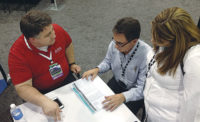The master distribution game, particularly in the industrial PVF segment of the supply chain, is in a state of change.
Rob Raban, president of Rancho Dominguez, California-based Industrial Valco, an industrial PVF master, points out the recent increase in consolidation in the space. “Masters are consolidating both carbon and stainless with Smith-Cooper and Anvil merging, as well as FF & F and Ta Chen,” he says. “This trend started a few years ago with Allied Fitting buying Warren Alloys and Texas Pipe buying Dodson.”
And Raban doesn’t see this trend slowing down anytime soon. “The last downturn in 2016 resulted in Val-Fit and Team Alloy merging with other masters,” he said. “We are clearly in a downturn in industrial PVF, particularly those distributors weighted in the oil and gas segments. I would expect to see further consolidation.”
Another merger a year ago occurred with Merfish Pipe & Supply out of Houston and United Pipe & Supply out of the suburban Boston area joining forces. Merfish Pipe Holdings CEO Greg Leidner says the merger of import steel pipe-focused Merfish and United, and its broad basket of pipe products (steel, copper, PVC, strut, threaded rod, metal and PVC conduit), resulted in a much larger-scale pipe master distributor. “With the scale and breadth to service wholesalers from small fill-in orders to truckload quantities,” Leidner notes. “This adds a tremendous amount of value to the channel, providing wholesalers with the ability to get what they want, when they want it. Wholesalers can manage both cash flow and risk by utilizing the master distribution model for their commodity pipe needs. We anticipate this trend to continue over the next several years.
“We are on the lookout for continued consolidation during 2020. We see this market as having great opportunities for companies looking for growth partners to find like-minded companies to join. We are open to M&A discussions with any companies that fall into the master distribution category.”
More Changes
While mergers and acquisitions have been rampant, other master distributors are strengthening their approach with internal changes. South-suburban Chicago-based HVAC master distributor Neuco recently moved into a much larger facility, while saying goodbye to its former west-suburban home of 40 years. “The new facility allowed us to modernize all of our routines and processes, and we all learned a ton during those efforts,” Neuco Vice President Jon Neustadt says. “Planning for and then going live in our new facility has taught us many lessons with regards to really considering and evaluating how we do things. We always are looking for additional efficiencies, but always in conjunction with our team, whose efforts ultimately allow us to serve our customers and vendors.”
Industrial Valco continues to challenge itself with its SPEEDABILITY program, “which is our brand promise to have what our customers are looking for in stock, error free and ready, in two hours or less,” Raban says.
Raban adds to that end the company launched an e-commerce site at ivalco.com, which enables customers 24/7 access to inventory for online ordering, pricing, document requests, as well as product training videos. “We have invested three years of development into the site and we’re very excited to see it take off the way it has. We’re currently adding 100 users per month and just hit 1,000 users in January,” he says.
Leidner says the new combined company has been hard at work converging onto one Merfish United ERP system, “that will positively impact our ability to provide customers with top-level customer service,” he says. “Additionally, we already have started to stock our entire basket of products in each of our 15 distribution centers around the country.”
On the PHCP side of things, The Stock Market & HM Wallace (both Ferguson Enterprises) General Manager Jon Schmidt notes all sides of the supply chain are looking for vertical integration opportunities. “Openly, these are risk factors for master distribution, but only if we are not listening to these partners, hearing their pain points and having robust dialogue on the most efficient way to create or preserve value,” he explains. “The Stock Market has invested significant resources and dollars into a business model that delivers tremendous value for the mid-and-long tail of a vendor catalog.
“The most unsustainable outcomes happen when any party, vendor, master distributor or reseller/wholesaler ventures into a new territory without a measured approach and a true solution for that function, which previously another party managed. Disruption and innovation are good for everyone, but movement for the sake of movement can have unintended consequences.”
Waterworks master Westcoast Water Works Warehouse (W4) is focusing on e-commerce with a new website and software system that President Brian Voss says will be live at the end of Q1. The company also is devoting major time to the gas market in order to grow that segment this year, he says. “I think our business will keep growing at a 10%-plus range in 2020 because of a lot of ongoing projects already in the works,” Voss notes.
What Does the Future Hold?
Raban points out capex spending from the oil majors, which drives project activity, is down significantly. He cites data where 33 oil and gas producers and 15 oilfield service companies filed for bankruptcy last year. “Investors are demanding a return on their investment and capital availability is tightening, which will further restrict capex budgets going forward,” he says. “2018 was fairly healthy, 2019, not so much. 2020 appears to be similar to the last quarter of 2019. Oil prices contracted 25% in 2019 from 2018 levels, so that’s a big contributor to the slowdown in business.”
Sara Alford, general manager at Stafford, Texas-based Newmans Valve and the new president of the best practices PVF Roundtable group, sees many of the EPCs (engineering, procurement and construction) and end users delaying projects and doing more maintenance work in 2020. “This is good for master distributors since we can only sell through distribution, and MRO work is right up our alley,” she says. “In 2020, the things to look for are those MRO/shutdown opportunities to keep the business flourishing during times when project work is not at the forefront of this business. Newmans Valve had a successful 2019 and we are predicting an uptick in 2020 as it relates to MRO and quick-turn business.”
Alford says Newmans continues to place stock orders with its suppliers to serve the small- and mid-sized distributors. “Everyone has cut back on their stock order with manufacturers,” she says. “When it comes to MRO/shutdown work, you need to have it on the shelf to make the sale. We are ready for those calls where we will continue to serve our customer base with a fair price and first-class customer service.”
Because of continued volatility in the market, Tim Williamson, president of St. Louis, Missouri-based Service Metal, says it’s a good time to be a master distributor on a number of levels.
“Master distribution adds the most value in a challenging trade environment such as the one we are in now,” he explains. “The import landscape is changing rapidly, and identifying reliable, quality manufacturers is increasingly difficult due to trade suits, tariff challenges and the occasional bad actor. Pricing fluctuation due to long lead times also can present a challenge for supply houses. Market conditions can change rapidly and the cost from overseas buying is often out of date by the time the material is received into stock. Master distribution effectively mitigates these challenges. We are seeing more and more supply houses, even larger supply houses, rely on masters for stock, short buys and jobs.
“We expect to see supply houses continue to use maters to dial in stock levels and maximize their profitability through faster turns. The master who can deliver quickly and make their customers’ jobs easy will add the most value to the supply chain.”
Schmidt says The Stock Market/HM Wallace success strategy going forward contains no secret ingredients. “It’s not glamorous,” he says, “just staying focused on the fundamentals. Listen to our customers and vendors, be honest about why we are winning or losing, build plans to create more value and then execute those plans.”






